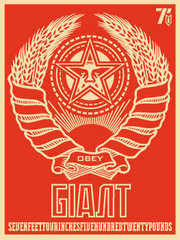Coat of Arms of the Soviet Union
From The Giant: The Definitive Obey Giant Site
From Wikipedia:
The state coat of arms of the Soviet Union was adopted in 1923 and was used until the break-up of the Soviet Union in 1991. Although it technically is an emblem rather than a coat of arms, since it doesn't follow heraldical rules, in Russian it is called герб (transliteration: gerb), the word used for a traditional coat of arms.
History
First version (1923-1936)
The project of the first version of the coat of arms was accepted on July 6, 1923 by the 2nd session of the Central Executive Committee (CIK) of the USSR and the version was completed on September 22 of that year. This design was fixed in the 1924 Soviet Constitution: "The State Emblem of the USSR is composed of a sickle and a hammer on a globe depicted in the rays of the sun and framed by ears of wheat, with the inscription 'Workers of All Countries, Unite!' in six languages - Russian, Ukrainian, Byelorussian, Georgian, Armenian, Turko-Tatar. At the top of the Emblem is a five-pointed star."
Second version (1936-1946)
According to the 1936 Soviet Constitution, the USSR consisted of eleven republics. Hence the major new version's difference from the previous one were eleven ribbons bearing USSR State Motto inscriptions in eleven languages.
Third version (1946-1956)
The state coat of arms of the Soviet Union, between 1946 and 1956. The number of republics in the USSR became 16 shortly before the Great Patriotic War, but the coat of arms was changed to reflect this only after the war. By a Decision of Presidium of the Supreme Soviet of the USSR of June 26, 1946, all 16 constituent republics were represented on the coat of arms. The USSR State Motto was inscribed on 16 ribbons in 16 languages (Estonian, Latvian, Lithuanian, Moldavian, Finnish languages were added to the previous version). Inscriptions in Azerbaijani, Turkmen, Uzbek, Tajik, Kazakh, Kyrgyz languages were updated due to the transfer from the Latin alphabet to Cyrillic alphabet of respective republics.
Fourth version (1956-1991)
In 1956 Karelo-Finnish SSR was transformed into Karelo-Finnish ASSR and soon this was reflected on the USSR coat of arms. By a Decision of Presidium of the Supreme Soviet of the USSR of September 12, 1956, a ribbon bearing the USSR State Motto in Finnish was removed.
One more minor change was introduced into the USSR State Motto in Byelorussian language by a Decision of the Presidium of Supreme Soviet of the USSR of April 1, 1958.
Description
The coat of arms shows the traditional Soviet emblems of the hammer and sickle and the Red Star over a globe, and two wreaths of wheat covered by the USSR State motto ("Workers of the World, Unite!") in the official languages of the Soviet Republics, in the reverse order they were mentioned in the Constitution of the Soviet Union.
Each Soviet Republic (SSR) and Autonomous Soviet Republic (ASSR) had its own coat of arms, largely inspired by the coat of arms of the Union.
The Coat of Arms of the Soviet Union served as the model for Shepard Fairey's 2001 print Wreath.
© Copyright |
|---|
| This page contains an image or images of drawings, paintings, photographs, prints, or other two-dimensional works of art, for which the copyright is presumably owned by either the artist who produced the image, the person who commissioned the work, or the heirs thereof. It is believed that the use of low-resolution images of works of art for critical commentary on the work in question, the artistic genre or technique of the work of art, or the school to which the artist belongs on the English-language website thegiant.org, hosted on servers in the United States, qualifies as fair use under United States copyright law. |

